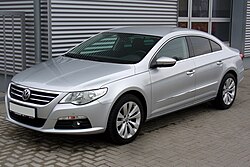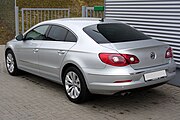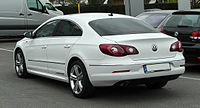VW CC
| Volkswagen | |
|---|---|
|
VW Passat CC (2008-2012)
|
|
| Passat CC (type 35) | |
| Production period: | 2008-2017 |
| Class : | Middle class , upper middle class |
| Body versions : | limousine |
| Engines: |
Otto engines : 1.4–3.6 liters (110–220 kW) Diesel engines : 2.0 liters (103–135 kW) |
| Length: | 4799-4802 mm |
| Width: | 1855 mm |
| Height: | 1417-1421 mm |
| Wheelbase : | 2708-2711 mm |
| Empty weight : | 1489-1707 kg |
| successor | VW Arteon |
The VW CC (until the beginning of 2012 VW Passat CC ) is a Volkswagen brand vehicle sold as a four-door coupé . The first generation was based on the Passat B6 and was manufactured at the VW plant in Emden . The additional designation CC stands for Comfort Coupé . In some countries (e.g. USA , South Africa ), the model was only marketed as a Volkswagen CC from the start . This name has also been used in Germany since the facelift in February 2012. In China the car is called Magotan CC and in Russia it was always called Passat CC before and after the facelift .
The car was presented to the public at the Detroit Motor Show in 2008 and launched on the European market in May of the same year, and in the US six months later. The Passat CC was positioned between the Passat and the VW Phaeton .
In 2018, the second generation of the CC, which is known as Arteon in Germany , was presented for the Chinese market at Auto China .
Mark
The platform corresponds - with a few exceptions - to the Passat sedan. The main difference between the CC and the latter is that it has a flatter roof (−50 mm); it is also 36 mm wider and has a track that is 11 mm larger at the front and 16 mm larger at the rear. The luggage compartment volume of 532 liters, which is unusually large for a coupé, can be expanded by folding down the rear seats. With its frameless doors and gently sloping C-pillar , the car was considered a “finer” Passat.
The Passat CC was offered at prices starting at 30,575 euros. The prices for the CC in model year 2017 started at 33,275 euros.
Innovations
Compared to the Passat sedan, the level of safety has been further increased by a number of innovations and electronic systems for active and passive safety.
Further innovations were available, most of which were also adopted in the other Passat variants. These include adaptive cruise control , which automatically maintains the set speed-dependent distance from the vehicle in front in the speed range from 30 to 210 km / h, the self-steering parking aid known as Park Assist and, according to VW, the world's first active lane-keeping assistant, Lane Assist , to intervene in the steering lane markings are recorded with a camera and automatically counter-steered before leaving a lane. When driving at night, this camera constantly records the traffic situation and controls the variable xenon light distribution using the Dynamic Light Assist (DLA) system. Also available is a rear-view camera, are hard drives - navigation system , a mobile phone with SIM access via radio and a multimedia port.
New were the adaptive shock absorbers called Dynamic Chassis Control (DCC) , which can be switched to one of the three modes normal, sport or comfort using a selector switch. In addition, the shock absorbers are automatically adapted to the road conditions within the map of the activated mode while driving. The responsiveness of the steering is also adapted to the selected mode.
Facelift
The Passat CC was revised in February 2012. The name Passat was dropped, so that the vehicle has only been called CC since then .
The shape has been adapted to that of the Passat B7 , which can be seen in a modified radiator grille, different headlights and modified rear lights.
Technically, there were initially no innovations, but in autumn 2012 the 1.8 TSI was replaced by an equally powerful 1.4 l engine and the output of the 2.0 TDI increased from 125 kW (170 PS) to 130 kW (177 kW) PS) raised. Production was stopped in November 2016. A new coupé took over in 2017 under the name VW Arteon .
Engines
The engine range initially comprised two gasoline engines and one diesel engine. The diesel segment was later expanded to include a version with 125 kW (170 hp). The gap between the smallest gasoline engine and the top V6 model is filled by a 2-liter gasoline engine with 155 kW (211 hp). The top model has a 3.6-liter six-cylinder petrol engine and is equipped as standard with a dual clutch transmission (DSG) and 4Motion all-wheel drive .
Petrol engines
| 1.4 TSI BMT | 1.4 TSI | 1.8 TSI | 2.0 TSI | 3.6 V6 FSI | ||
|---|---|---|---|---|---|---|
| Construction period | 04/2015–11/2016 | 10/2012–04/2015 | 03/2008–10/2012 | 04/2008–10/2010 | since 10/2010 (Europe: until 04/2015) | since 03/2008 (Europe: until 04/2015) |
| Engine code | CZDA | CKMA | BZB, CDAA | CAWB | CCZB | BWS, CNNA |
| Motor series | VW EA211 | VW EA111 | VW EA888 | VW EA390 | ||
| Engine type | In-line design , direct injection | VR design , gasoline direct injection | ||||
| Engine charging | turbocharger | Turbocharger, compressor | turbocharger | - | ||
| Cylinders / valves | 4/16 | 6/24 | ||||
| Displacement | 1395 cc | 1390 cm³ | 1798 cc | 1984 cc | 3597 cc | |
| Max. Power at min −1 | 110 kW (150 PS) / 5000–6000 |
118 kW (160 PS) / 5500 |
118 kW (160 PS) / 5000–6200 |
147 kW (200 PS) / 5100-6000 |
155 kW (211 PS) / 5300-6200 |
220 kW (299 hp) / 6600 |
| Max. Torque at min -1 | 250 Nm / 1500-3500 |
240 Nm / 1500-4500 |
250 Nm / 1500-4200 |
280 Nm / 1700-5000 |
280 Nm / 1700-5200 |
350 Nm / 2400-5300 |
| Drive type, standard | Front wheel drive | all wheel drive | ||||
| Transmission type, standard | 6-speed manual transmission | 6-speed DSG | ||||
| Transmission type, optional | 7-speed DSG | 6-speed DSG 1 | 6-speed DSG | - | ||
| Empty weight | 1489-1497 kg | 1505-1531 kg | 1505-1521 kg | 1511-1533 kg | 1513-1535 kg | 1702-1707 kg |
| maximum payload | 496-508 kg | 514-520 kg | 490-534 kg | 509-554 kg | 530-542 kg | 478-503 kg |
| Acceleration, 0-100 km / h | 8.9 s | 8.5 s | 8.5-8.6 s | 7.6-7.8 s | 7.6 s | 5.5-5.6 s |
| Top speed | 218 km / h | 222 km / h | 220-222 km / h | 232-237 km / h | 238–240 km / h | 250 km / h (governed) |
| Fuel consumption over 100 km, combined | 5.3-5.8 l super | 6.2–6.6 l super | 7.1–7.6 l super | 7.9–8.5 l super | 7.3–7.8 l super | 9.2-10.1 l Super plus |
| CO 2 emissions, combined | 131-134 g / km | 144-152 g / km | 164-180 g / km | 183-199 g / km | 169-182 g / km | 213-242 g / km |
| Emission standard according to EU classification | Euro 6 | 5 euro | 5 euro | Euro 4 | 5 euro | 5 euro |
Diesel engines
| 2.0 Blue TDI | 2.0 TDI | 2.0 TDI BMT | 2.0 TDI | 2.0 TDI BMT | |||
|---|---|---|---|---|---|---|---|
| Construction period | 11/2010 - 04/2015 | 05/2009–10/2010 | 03/2008 - 04/2015 | 04/2015–11/2016 | 06/2008–10/2012 | 10/2012–04/2015 | 04/2015–11/2016 |
| Engine code | CBAB, CFFB | CBAC | CBAB, CFFB | CUVC | CBBB, CFGB | CFGC | CUWA |
| Motor series | VW EA189 | VW EA288 | VW EA189 | VW EA288 | |||
| Engine type | Series design, common rail injection , diesel soot particle filter , SCR catalytic converter | Series design, common rail injection , diesel soot particle filter | |||||
| Engine charging | turbocharger | ||||||
| Cylinders / valves | 4/16 | ||||||
| Displacement | 1968 cc | ||||||
| Max. Power at min −1 | 103 kW (140 PS) / 4200 |
105 kW (143 PS) / 4200 |
103 kW (140 PS) / 4200 |
110 kW (150 PS) / 3500-4000 |
125 kW (170 PS) / 4200 |
130 kW (177 PS) / 4200 |
135 kW (184 PS) / 3500-4000 |
| Max. Torque at min -1 | 320 Nm / 1750-2500 |
340 Nm / 1750-3000 |
350 Nm / 1750-2500 |
380 Nm / 1750-2500 |
380 Nm / 1750-3250 |
||
| Drive type, standard | Front wheel drive | ||||||
| Drive type, optional | - | all wheel drive | - | all wheel drive | - | ||
| Transmission type, standard | 6-speed manual transmission | ||||||
| Transmission type, optional | 6-speed DSG | ||||||
| Empty weight | 1582-1592 kg | 1565-1595 kg | 1540-1640 kg | 1573-1596 kg | 1548-1627 kg | 1565-1683 kg | 1590-1607 kg |
| maximum payload | 493-503 kg | 510-520 kg | 485-524 kg | 464-538 kg | 500-503 kg | ||
| Acceleration, 0-100 km / h | 9.9 s | 9.8-10.2 s | 9.1 s | 8.6 s | 8.4 s | 8.1 s | |
| Top speed | 212-214 km / h | 211-214 km / h | 209–214 km / h | 218 km / h | 220-227 km / h | 232-234 km / h | |
| Fuel consumption over 100 km, combined | 4.7-5.4 l diesel | 5.3-5.9 l diesel | 4.6–6.2 l diesel | 4.3–4.9 l diesel | 4.8–6.4 l diesel | 4.8-5.7 l diesel | 4.9-5.1 l diesel |
| CO 2 emissions, combined | 122-142 g / km | 139-155 g / km | 120-163 g / km | 113-130 g / km | 125-168 g / km | 125-149 g / km | 127-133 g / km |
| Emission standard according to EU classification | Euro 6 | 5 euro | Euro 6 | 5 euro | Euro 6 | ||
Quality defects
According to the “ TÜV Report 2019” by Auto Bild , the VW CC is increasingly noticeable due to qualitative deficiencies from the first general inspection . It is unclear "why the number of defects is sometimes higher than with the normal notchback or station wagon Passat despite the lower mileage". Suspensions, springs and dampers are conspicuous, and ADAC also reports problems with the fuel pump, the injection nozzles, the rear wheel brake cylinder and the turbocharger . The situation worsens noticeably from a vehicle age of five years, later there are often further deficiencies in the area of the drive shafts and the examination of the engine management and emission control system is also frequently unsuccessful. Only from the year of construction 2011 does the ADAC achieve significantly better results.
Web links
- The Volkswagen CC. (No longer available online.) In: volkswagen.de. Archived from the original on November 11, 2016 ; accessed on November 27, 2017 .
Individual evidence
- ↑ Electric, networked and spacious for China. volkswagenag.com, accessed on May 2, 2018.
- ↑ a b Frankfurter Rundschau : Coupé with defects - The VW Passat CC is a beautiful thing with downsides , January 1, 2019, accessed on January 2, 2019.
- ↑ The Volkswagen CC, technology and prices, valid for the 2017 model year. (PDF) (No longer available online.) Archived from the original on January 26, 2017 ; accessed on November 27, 2017 .
- ↑ VW Techniklexikon ( Memento from September 24, 2010 in the Internet Archive ) (accessed on February 2, 2010)






